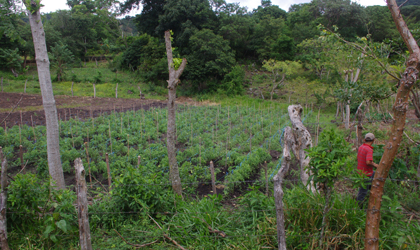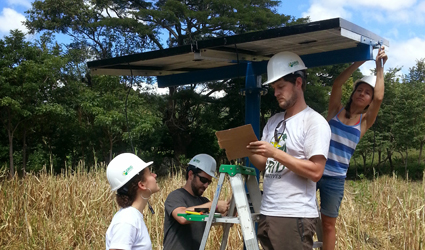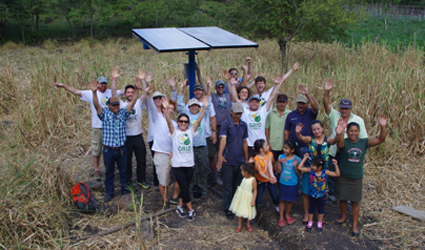 In December 2014, GRID Alternatives’ International Program launched a pilot project to improve the lives of small farmers in rural Nicaragua. GRID Alternatives volunteers worked with local families and partners, Suni Solar S.A. and the National Union of Growers and Livestock Farmers (UNAG), to install a solar-powered drip irrigation system to provide water for fruits and vegetable crops to small family-run farms.
In December 2014, GRID Alternatives’ International Program launched a pilot project to improve the lives of small farmers in rural Nicaragua. GRID Alternatives volunteers worked with local families and partners, Suni Solar S.A. and the National Union of Growers and Livestock Farmers (UNAG), to install a solar-powered drip irrigation system to provide water for fruits and vegetable crops to small family-run farms.
Agriculture continues to be one of the dominant economic sectors of the country. Most of the communities we currently work with include subsistence farmers that live off of the land, growing just enough food to consume like corn, beans and wheat. Those who are able to grow fruits and vegetables do so on a small scale (fewer than four acres) and are able to sell their crops at the local market. However, small farmers face a number of challenges. Many farmers rely on diesel-powered or gasoline-powered motors to pump water to their crops, which is very costly, polluting, and time consuming for the farmer to travel to obtain fuel. Those who cannot afford a motor irrigate by hauling water in buckets from a well or nearby river. In both cases, watering crops in the dry season is difficult, limiting the farmer’s annual yield.
 A 5-horse-power motor can cost anywhere between US$1,500-$3,000. It takes the average farmer one gallon of fuel to pump an area of 1.72 acres (one manzana). If irrigated three times a week the farmer can spend an average of US$14 a month just on fuel to irrigate a small plot of land – and this does not include all of the maintenance costs associated with maintaining the irrigation pump, tubing and motor. Once the crop is ready to sell, the farmer sells the crop to the local merchant at the market for a fee of up to 30 percent, leaving the farmer with very little profit.
A 5-horse-power motor can cost anywhere between US$1,500-$3,000. It takes the average farmer one gallon of fuel to pump an area of 1.72 acres (one manzana). If irrigated three times a week the farmer can spend an average of US$14 a month just on fuel to irrigate a small plot of land – and this does not include all of the maintenance costs associated with maintaining the irrigation pump, tubing and motor. Once the crop is ready to sell, the farmer sells the crop to the local merchant at the market for a fee of up to 30 percent, leaving the farmer with very little profit.
Connecting to grid electricity is not an option for most farmers either because the electric grid is not nearby or because the electric company charges farmers a higher commercial rates if the electricity is used for irrigation. An electric bill could be as high as C$1,900/month or US$73 so many farmers choose to use diesel or gas powered generator even when grid electricity is available. Fossil-fueled powered generators produce harmful emissions and the use of flood irrigation techniques wastes water and actually may decrease plant growth over time.
 By using solar-powered drip irrigation systems, farmers can save money, use water more efficiently, increase crop yields, reduce local pollution, add more locally produce to the market, improve the quality of their lives by having more disposable income to send their children to school, make improvements to their home, and get their crops to the local market faster.
By using solar-powered drip irrigation systems, farmers can save money, use water more efficiently, increase crop yields, reduce local pollution, add more locally produce to the market, improve the quality of their lives by having more disposable income to send their children to school, make improvements to their home, and get their crops to the local market faster.
Using a drip irrigation system also allows farmers to grow a wider variety of crops during dry season (May through October) like grenadine, papaya, passion fruit, cucumbers, tomatoes, carrots, sweet peppers and watermelon. Drip irrigation allows for greater flexibility for crop rotation cycles without damaging the soil.
Read the case study here.

